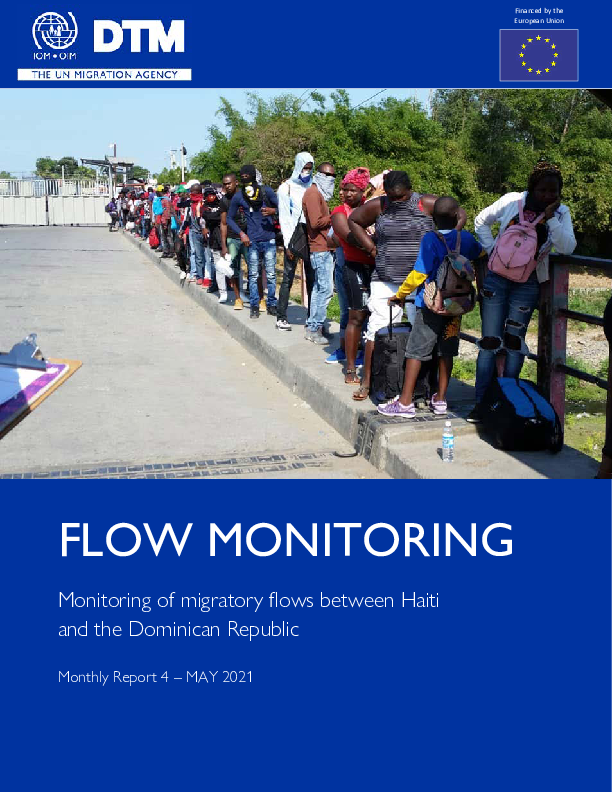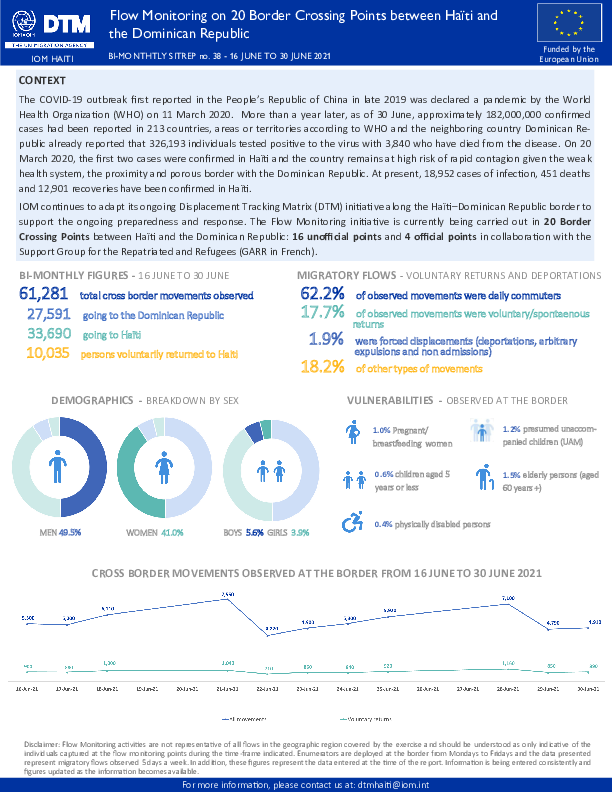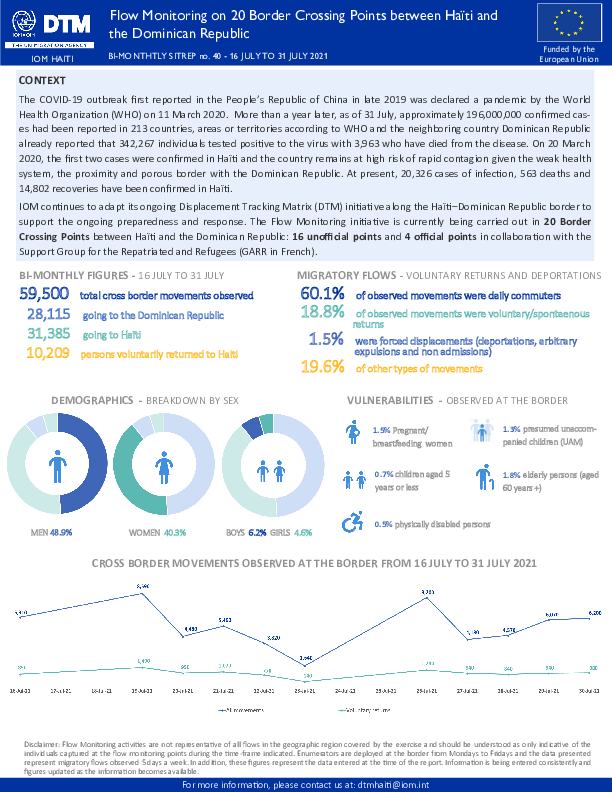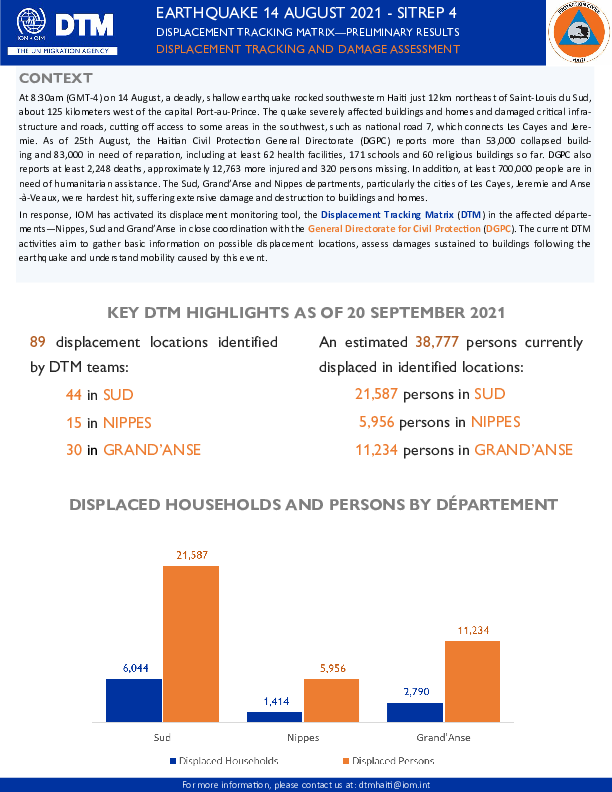-
Countries
-
Data and Analysis
-
Special Focus
-
Crisis Responses

Contact
DTM Haiti, DTMHaiti@iom.int
Language
English
Location
Haiti
Period Covered
May 01 2021
May 31 2021
Activity
- Flow Monitoring
The migration flow between Haiti and the Dominican Republic (DR) in the island of Hispaniola is highly active and challenging as it is estimated that over half a million foreign born persons are living as irregular migrants in the DR, the vast majority of which - (497,825 persons)1 - being from the neighboring Republic of Haiti. Consequently, migration management between Haiti and the Dominican Republic and the protection of vulnerable migrants remains a major challenge on the island.
Due to the significant influx of returnees and in support of the Government of Haiti, IOM Haiti has established a Displacement Tracking Matrix initiative which focuses on reinforcing monitoring and data collection of border movement between the two countries. Border & Flow Monitoring aims to provide information on cross border returns of migrants from the Dominican Republic into Haiti and support the systematic identification, registration and profiling of Haitian migrants returning and/or being deported at all border crossing points with the DR in to provide key information on risks, needs and migration patterns. The previous application of the Border and Flow Monitoring monitored migratory flows on 50 Border Crossing Points – 4 official and 46 unofficial. The current one covers 20 Border Crossing Points – 4 official and 16 unofficial in collaboration with the Support Group for the Repatriated and Refugees (GARR2 in French).

Contact
dtmhaiti@iom.int
Language
English
Location
Haiti
Period Covered
Jun 01 2021
Jun 15 2021
Activity
- Flow Monitoring
The COVID-19 outbreak first reported in the People’s Republic of China in late 2019 was declared a pandemic by the World Health Organization (WHO) on 11 March 2020. More than a year later, as of 15 June, approximately 176,000,000 confirmed cases had been reported in 213 countries, areas or territories according to WHO and the neighboring country Dominican Re public already reported that 311,833 individuals tested positive to the virus with 3,726 who have died from the disease. On 20 March 2020, the first two cases were confirmed in Haïti and the country remains at high risk of rapid contagion given the weak health system, the proximity and porous border with the Dominican Republic. At present, 17,239 cases of infection, 373 deaths and 12,645 recoveries have been confirmed in Haïti.

Contact
dtmhaiti@iom.int
Language
English
Location
Haiti
Period Covered
Jun 16 2021
Jun 30 2021
Activity
- Flow Monitoring
The COVID-19 outbreak first reported in the People’s Republic of China in late 2019 was declared a pandemic by the World Health Organization (WHO) on 11 March 2020. More than a year later, as of 30 June, approximately 182,000,000 confirmed cases had been reported in 213 countries, areas or territories according to WHO and the neighboring country Dominican Republic already reported that 326,193 individuals tested positive to the virus with 3,840 who have died from the disease. On 20 March 2020, the first two cases were confirmed in Haïti and the country remains at high risk of rapid contagion given the weak health system, the proximity and porous border with the Dominican Republic. At present, 18,952 cases of infection, 451 deaths and 12,901 recoveries have been confirmed in Haïti.

Contact
dtmhaiti@iom.int
Language
English
Location
Haiti
Period Covered
Jul 01 2021
Jul 15 2021
Activity
- Flow Monitoring
The COVID-19 outbreak first reported in the People’s Republic of China in late 2019 was declared a pandemic by the World Health Organization (WHO) on 11 March 2020. More than a year later, as of 15 July, approximately 189,000,000 confirmed cases had been reported in 213 countries, areas or territories according to WHO and the neighboring country Dominican Republic already reported that 336,693 individuals tested positive to the virus with 3,910 who have died from the disease. On 20 March 2020, the first two cases were confirmed in Haïti and the country remains at high risk of rapid contagion given the weak health system, the proximity and porous border with the Dominican Republic. At present, 19,762 cases of infection, 523 deaths and 13,332 recoveries have been confirmed in Haïti.

Contact
dtmhaiti@iom.int
Language
English
Location
Haiti
Period Covered
Jul 16 2021
Jul 31 2021
Activity
- Flow Monitoring
The COVID-19 outbreak first reported in the People’s Republic of China in late 2019 was declared a pandemic by the World Health Organization (WHO) on 11 March 2020. More than a year later, as of 31 July, approximately 196,000,000 confirmed cases had been reported in 213 countries, areas or territories according to WHO and the neighboring country Dominican Republic already reported that 342,267 individuals tested positive to the virus with 3,963 who have died from the disease. On 20 March 2020, the first two cases were confirmed in Haïti and the country remains at high risk of rapid contagion given the weak health system, the proximity and porous border with the Dominican Republic. At present, 20,326 cases of infection, 563 deaths and 14,802 recoveries have been confirmed in Haïti.

Contact
dtmhaiti@iom.int
Language
English
Location
Haiti
Period Covered
Aug 01 2021
Aug 15 2021
Activity
- Flow Monitoring
The COVID-19 outbreak first reported in the People’s Republic of China in late 2019 was declared a pandemic by the World Health Organization (WHO) on 11 March 2020. More than a year later, as of 15 August, approximately 205,000,000 confirmed cases had been reported in 213 countries, areas or territories according to WHO and the neighboring country Dominican Republic already reported that 346,459 individuals tested positive to the virus with 3,985 who have died from the disease. On 20 March 2020, the first two cases were confirmed in Haïti and the country remains at high risk of rapid contagion given the weak health system, the proximity and porous border with the Dominican Republic. At present, 20,732 cases of infection, 583 deaths and 16,866 recoveries have been confirmed in Haïti.

Contact
DTM Haiti, DTMHaiti@iom.int
Language
English
Location
Haiti
Snapshot Date
Sep 03 2021
Activity
- Mobility Tracking
At 8:30am (GMT-4) on 14 August, a deadly, shallow earthquake rocked southwestern Haiti just 12km northeast of Saint-Louis du Sud, about 125 kilometers west of the capital Port-au-Prince. The quake severely affected buildings and homes and damaged critical infrastructure and roads, cutting off access to some areas in the southwest, such as national road 7, which connects Les Cayes and Jeremie. As of 25th August, the Haitian Civil Protection General Directorate (DGPC) reports more than 52,953 collapsed building and 77,006 in need of reparation, including at least 25 health facilities, 127 schools and 60 religious buildings so far. DGPC also reports at least 2,207 deaths, approximately 12,268 more injured and 320 persons missing. In addition, at least 650,000 people are in need of humanitarian assistance. The Sud, Grand'Anse and Nippes departments, particularly the cities of Les Cayes, Jeremie and Anse-a-Veaux, were hardest hit, suffering extensive damage and destruction to buildings and homes.
In response, IOM has activated its displacement monitoring tool, the Displacement Tracking Matrix (DTM) in the affected départements – Nippes, Sud and Grand’Anse – in close coordination with the General Directorate for Civil Protection (DGCP). The current DTM activities aim to gather basic information on possible displacement locations, assess damages sustained to buildings following the earthquake and understand mobility caused by this event.
IOM works with national and local authorities in order to gain a better understanding of population movements throughout Southern Africa. Through the setup of Flow Monitoring Points (FMPs), IOM seeks to quantify migration flows, trends and routes and to gain a better understanding of the profiles of observed individuals at entry, transit or exit points (such as border crossing posts, bus stations, rest areas, police checkpoints and reception centres). This report is an overview of the data collected in these FMPs from 1 to 31 March 2022.
Inter-regional migration from and within the Southern Africa is categorized along the following corridors. The Flow Monitoring Points (FMPs) were set-up in several key transit locations along the corridors to track the movements of passengers:
•Zimbabwe (Mutare) – Mozambique (Manica)
•Zimbabwe – Zambia (Chirundu)
•Zimbabwe – Botswana (Plumtree)
•Zimbabwe (Beitbridge) – South Africa
•Malawi (Mchinji) - Zambia (Mwami)
•Malawi (Karonga ) – United Republic of Tanzania
•Malawi (Mwanza) – Mozambique (Zobue)
•Malawi (Mulanje) – Mozambique
•Mozambique (Ressano Garcia) – South Africa
Over the reporting period a total of 72,637 movements were observed across 45 FMPs in the region. The Zimbabwe – South Africa corridor hosted the largest number of movements with 49,483 (68%) followed by the Malawi (Mwanza) – Mozambique (Zobue) corridor with 7,783 (11%) and the Zimbabwe – Zambia corridor with 4,369 movements reported (6%).

Contact
DTM Haiti, DTMHaiti@iom.int
Language
English
Location
Haiti
Snapshot Date
Sep 20 2021
Activity
- Mobility Tracking
At 8:30am (GMT-4) on 14 August, a deadly, shallow earthquake rocked southwestern Haiti just 12km northeast of Saint-Louis du Sud, about 125 kilometers west of the capital Port-au-Prince. The quake severely affected buildings and homes and damaged critical infrastructure and roads, cutting off access to some areas in the southwest, such as national road 7, which connects Les Cayes and Jeremie. As of 25th August, the Haitian Civil Protection General Directorate (DGPC) reports more than 53,000 collapsed building and 83,000 in need of reparation, including at least 62 health facilities, 171 schools and 60 religious buildings so far. DGPC also reports at least 2,248 deaths, approximately 12,763 more injured and 320 persons missing. In addition, at least 700,000 people are in need of humanitarian assistance. The Sud, Grand'Anse and Nippes departments, particularly the cities of Les Cayes, Jeremie and Anse-a-Veaux, were hardest hit, suffering extensive damage and destruction to buildings and homes.
In response, IOM has activated its displacement monitoring tool, the Displacement Tracking Matrix (DTM) in the affected départements – Nippes, Sud and Grand’Anse – in close coordination with the General Directorate for Civil Protection (DGCP). The current DTM activities aim to gather basic information on possible displacement locations, assess damages sustained to buildings following the earthquake and understand mobility caused by this event.

Contact
RO Dakar, RODakar-DataResearch@iom.int
Language
French
Location
Senegal
Period Covered
Jan 01 2022
Feb 28 2022
Activity
- Other
- Flow Monitoring
L'Outil de suivi des zones de départ surveille les événements liés aux mouvements migratoires des côtes du Sénégal vers les îles Canaries espagnols (qui, le plus souvent, se déroulent à travers plusieurs étapes intermédiaires), dans le but de documenter la mobilité le long de la route atlantique ouest-africaine (WAAR). Ce rapport présente les données collectées par l'outil de suivi des départs entre le 1er janvier et le 28 février 2022 aux principaux points de départ le long du littoral sénégalais. Les informations sont fournies aux agents recenseurs par les Points Focaux Communautaires (PFC) qui fournissent des informations sur les événements notables observés dans les zones de départ utilisées par les migrants pour se rendre en Mauritanie, au Maroc et aux îles Canaries.
